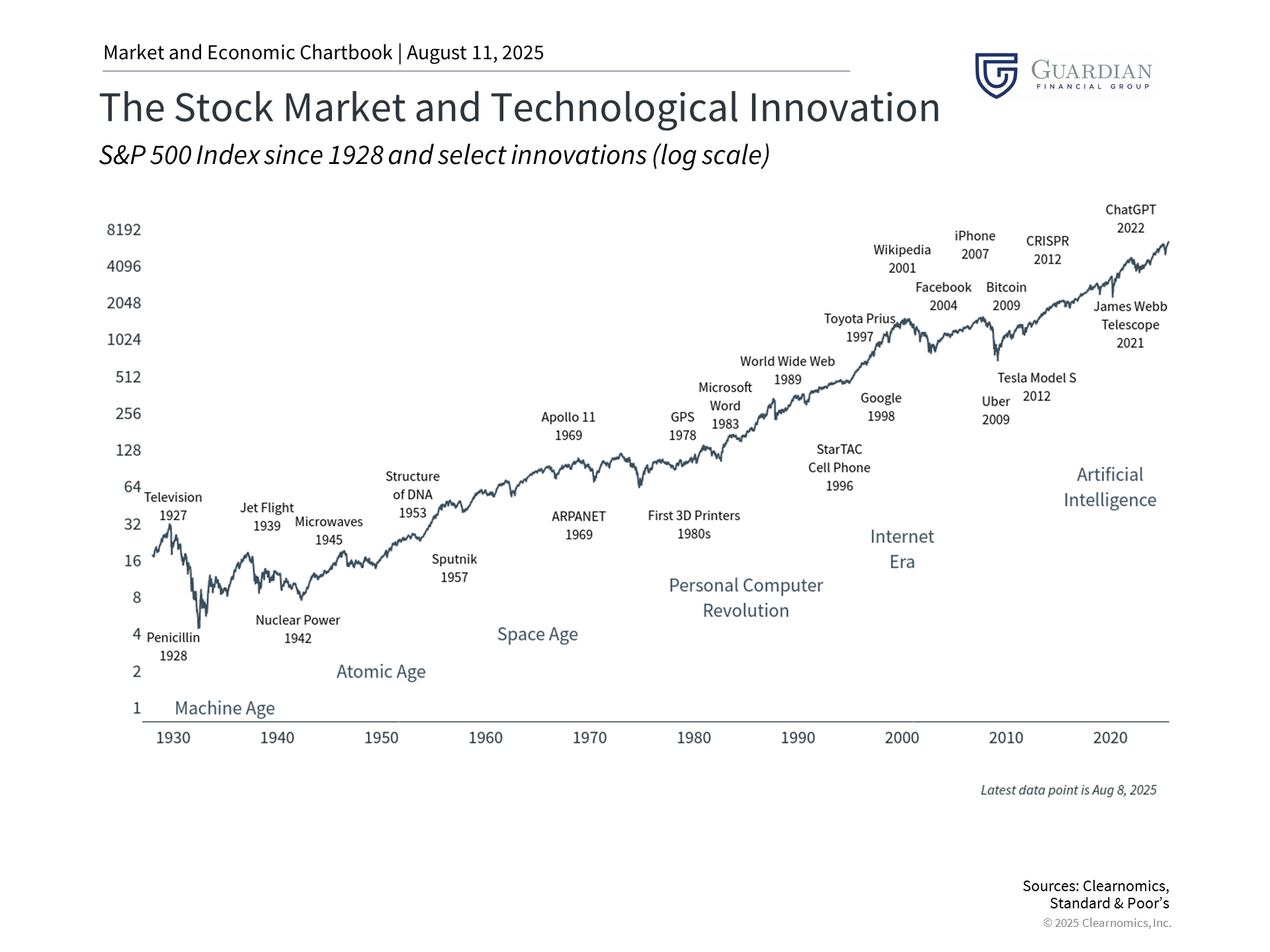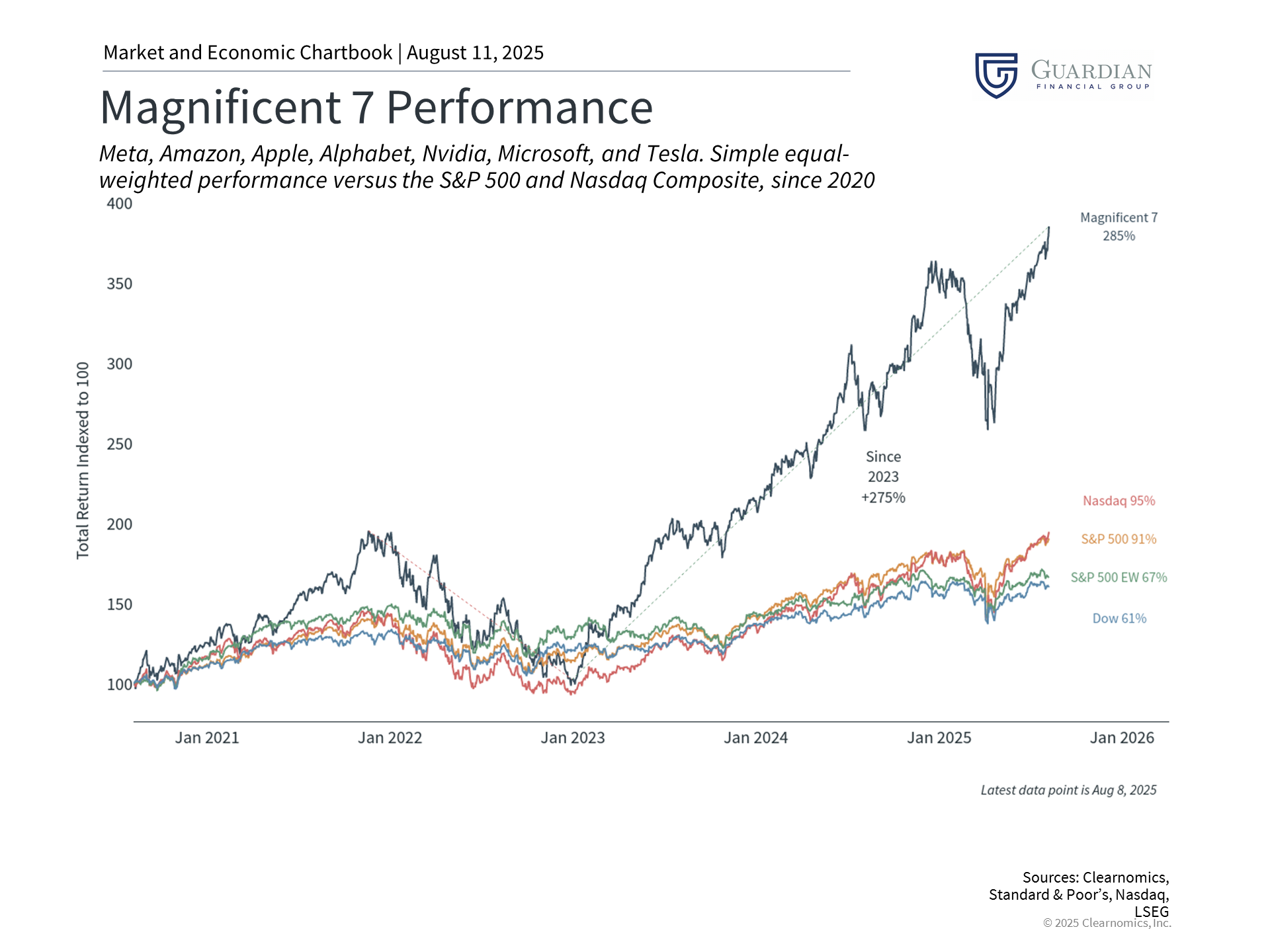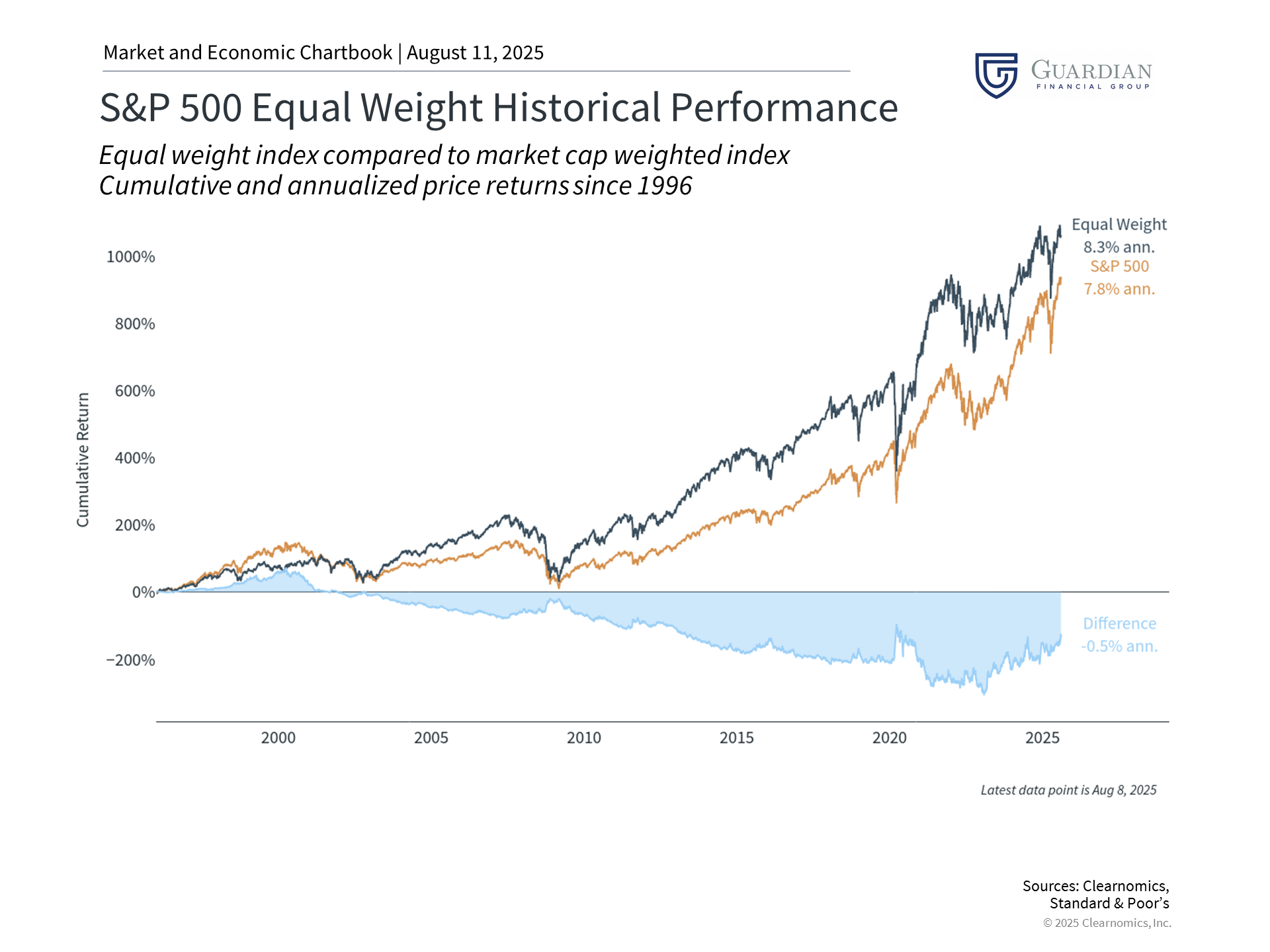
Are AI Stocks Too Concentrated for Safe Investing?
 | |||
Market Concentration and AI: Navigating Investment Opportunities and RisksAugust 11, 2025 | |||
Today's investors face a key question: how to balance their portfolios while markets reach record highs driven by artificial intelligence developments. Although it may be appealing to concentrate on recently successful companies, achieving long-term financial objectives demands a balanced approach that considers both potential returns and risk mitigation.
Large-cap technology companies, particularly those capitalizing on AI advancements, are often grouped together as the "Magnificent 7." This collection - consisting of Apple, Microsoft, Nvidia, Amazon, Alphabet, Meta, and Tesla - currently makes up approximately 35% of the S&P 500 and includes seven of the eight most valuable companies. Many of these are also classified as "hyperscalers" because of their substantial investments in computing infrastructure to support expanding AI application requirements.
During market periods characterized by a small number of stocks driving most performance gains, focusing on historical context, present valuations, and portfolio allocation becomes increasingly crucial. Examining how comparable periods of market concentration have unfolded previously can guide investors toward more informed decisions regarding their long-term financial strategies.
Technology drives long-term market performance
Although AI and railroads may appear unrelated, history demonstrates that revolutionary technologies typically follow comparable trajectories. During the 1860s, railroad companies commanded American markets similarly to how technology stocks dominate today. The Pennsylvania Railroad company once held the distinction of being the world's largest corporation and, together with other railroad companies, comprised a substantial portion of the entire stock market. This naturally generated market excitement and increasing valuations that would resonate with contemporary investors.
This cycle has recurred throughout history. The 1990s dot-com surge, when investors concentrated almost entirely on internet businesses, offers perhaps the most relevant recent illustration. However, dating back to the 1800s, innovations like the telegraph, electrical power, and telephone systems revolutionized urban areas and spawned numerous new enterprises. During the 1900s, the electronics and computing revolution transformed every aspect of society and commerce, even preceding internet development.
These technological waves shared a common progression: initial doubt, swift implementation, market excitement, and ultimate incorporation into the wider economy. Railroads persisted but evolved into standard components of transportation and logistics industries, supporting overall economic activity. Although many dot-com enterprises collapsed during the late 1990s and early 2000s, numerous others evolved into today's technology giants.
Regarding long-term investment strategy, it's crucial to consider not only individual corporations but also how emerging technologies influence the broader market and economic landscape. Ultimately, innovation's genuine benefit lies in enhanced productivity and efficiency throughout all industries. The critical distinction is that while individual company stock prices may fluctuate rapidly, the comprehensive economy-wide impacts require considerably more time to materialize.
Historical evidence demonstrates that valuations are as important as growth
Currently, the question centers not on AI's significance, but on whether existing valuations are justified. With the S&P 500 trading at a 22.5x price-to-earnings multiple, approaching the record high of 24.5x, investors are paying prices that presume these developments will maintain their current momentum.
What factors contribute to elevated valuations for the Magnificent 7? Initially, recent data indicates U.S. private AI investment totaled $109 billion in 2024, with hundreds of billions additional announced for this year. This amount surpasses entire national GDPs and significantly exceeds comparable investments by other regions. During recent quarters, investors have responded favorably to announcements of increasingly larger AI infrastructure expenditures. This represents a notable change from less than twelve months ago when investors questioned whether these corporate investments would generate returns.
Additionally, numerous organizations and individual users have quickly embraced AI technologies, generating increasing demand for computational capacity. This explains why "hyperscalers" such as Microsoft and NVIDIA have experienced dramatic market capitalization increases, with both reaching valuations exceeding $4 trillion. This also accounts for why demand for additional data centers and their power requirements remain primary investor concerns.
These corporations are viewed as constructing the foundation that enables other enterprises to implement AI technologies, similar to how railroad companies established transportation infrastructure supporting all 19th-century businesses. While this generates substantial long-term value, the timeframe for achieving returns remains unpredictable.
The difficulty lies in markets frequently overestimating how quickly transformative technologies will produce profits, even when long-term potential may be genuine. The 1990s provide a warning example. During that period, some investors believed conventional valuation measures no longer applied to internet companies. When outcomes failed to meet expectations, the Nasdaq declined 78% from its peak, and many companies failed or were purchased. Nevertheless, the internet did reshape the economy, just not within the timeframe or manner that peak valuations suggested.
Managing opportunities alongside concentration risk
Likewise, while the Magnificent 7 companies may have guided the market upward, they have also led it downward. For instance, during 2022 when interest rates increased rapidly due to inflation, these stocks declined approximately 50% on average.
Given that the Magnificent 7 now constitutes such a significant share of major market indexes, virtually all investors hold these stocks within their portfolios. For those who have emphasized technology stocks, their portfolio weightings may exceed intended levels.
Maintaining excessive portfolio exposure to just a few investments is commonly termed "concentration risk," representing the opposite of diversification. While these companies have shown growth and profitability, having substantial portfolio portions dependent on a small group of companies, regardless of their success, can generate volatility as market trends shift. Even exceptional companies can experience underperformance periods.
For context, consider the equal-weighted S&P 500 displayed in the above chart, which assigns identical importance to each company irrespective of size. This methodology has historically delivered different return characteristics than the standard market-capitalization weighted index, sometimes outperforming when large companies face difficulties.
Since mega-cap technology companies have recently performed well, some investors may find it unexpected that an equal-weighted index has still delivered superior performance over the past 30 years. This emphasizes the significance of not exclusively focusing on recent market drivers and current headlines.
This doesn't suggest investors should completely avoid technology stocks. Instead, it underscores the importance of maintaining balance and proper asset allocation.
The bottom line? Present AI developments present both opportunities and risks for investors. Investment success depends not on selecting winning stocks, but on maintaining proper portfolio balance aligned with long-term objectives. | |||
Advisory services through Cambridge Investment Research Advisors, Inc., a Registered Investment Adviser. Cambridge and Guardian Financial Group are not affiliated. Copyright (c) 2025 Clearnomics, Inc. All rights reserved. The information contained herein has been obtained from sources believed to be reliable, but is not necessarily complete and its accuracy cannot be guaranteed. No representation or warranty, express or implied, is made as to the fairness, accuracy, completeness, or correctness of the information and opinions contained herein. The views and the other information provided are subject to change without notice. All reports posted on or via www.clearnomics.com or any affiliated websites, applications, or services are issued without regard to the specific investment objectives, financial situation, or particular needs of any specific recipient and are not to be construed as a solicitation or an offer to buy or sell any securities or related financial instruments. Past performance is not necessarily a guide to future results. Company fundamentals and earnings may be mentioned occasionally, but should not be construed as a recommendation to buy, sell, or hold the company's stock. Predictions, forecasts, and estimates for any and all markets should not be construed as recommendations to buy, sell, or hold any security--including mutual funds, futures contracts, and exchange traded funds, or any similar instruments. The text, images, and other materials contained or displayed in this report are proprietary to Clearnomics, Inc. and constitute valuable intellectual property. All unauthorized reproduction or other use of material from Clearnomics, Inc. shall be deemed willful infringement(s) of this copyright and other proprietary and intellectual property rights, including but not limited to, rights of privacy. Clearnomics, Inc. expressly reserves all rights in connection with its intellectual property, including without limitation the right to block the transfer of its products and services and/or to track usage thereof, through electronic tracking technology, and all other lawful means, now known or hereafter devised. Clearnomics, Inc. reserves the right, without further notice, to pursue to the fullest extent allowed by the law any and all criminal and civil remedies for the violation of its rights.  |





